4000 years of lived history. The Patriarch and the Millennial Olive Trees of Luras, Sardinia. 🇬🇧 / 4000 anni di storia vissuta. Il Pratriarca e gli Olivastri Millenari di Luras, Sardegna. 🇮🇹
🇬🇧
Good morning dear friends of Hive, some of you may have heard about it or seen on television, on the Freedom program, but believe me, to be in person before the Patriarch, the oldest wild olive in the world, as well as one of the longest-lived plants known on our planet , it is a unique emotion.

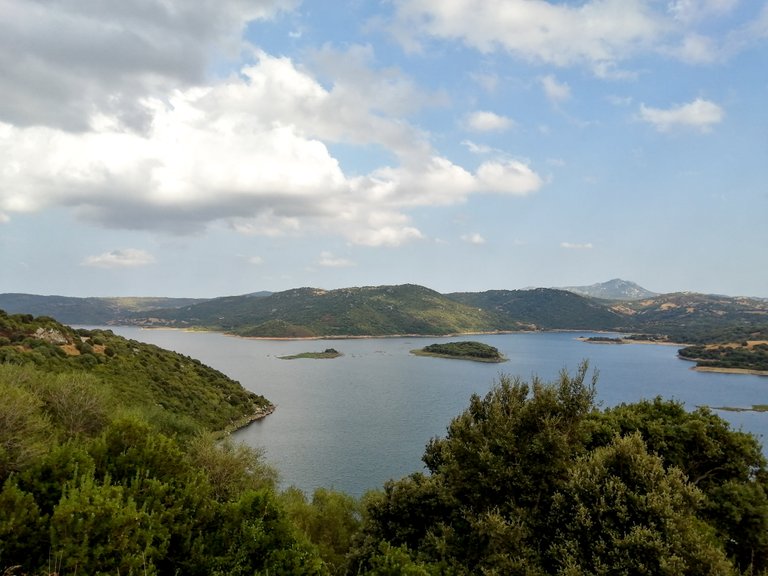
Liscia Lake, Luras.

Therefore, continuing our journey in the Sardinian hinterland, we were near Luras, where I knew, having seen the program on television, that there was a site called the Millenari Olivastri di Luras. As you know, I have an infinite passion for green thumb and botany, I couldn't miss this opportunity.
Arrived at the place of interest, near a beautiful freshwater basin, nestled between the mountains, the Liscia Lake, on one side of the same, was this small park, very well cared for, where, in the middle of a forest of olive trees (wild olive trees), there were three imposing plants of the same species, including the Patriarch. A spectacle of nature, which has been watching over the Gallura mountains for over 4000 years, like an emblem of tenacity. It represents the essence of life itself, like the trees that give the pure air to which all living beings are preparing and that allows us to continue in our humble existence, in the face of so much majesty.

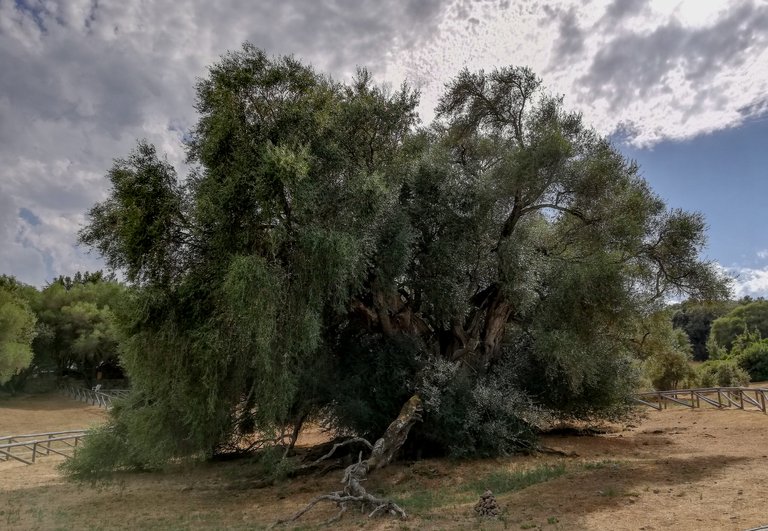
The Patriarch.

As for the presumed age, according to the information collected on the spot by the guide, it was thanks to studies carried out on another millenary olive tree, which had to be killed after being sick, it was possible to go back to the age of the Patriarch and his younger brothers , of 2500 and 500 years, through calculations based on the rings of the cut logs. Another information that was provided by the guide is that this type of tree continues to grow throughout its life, decreasing its growth rate as the years pass, only growing small fractions of a millimeter per year, when they reach an age like that of the Patriarch.

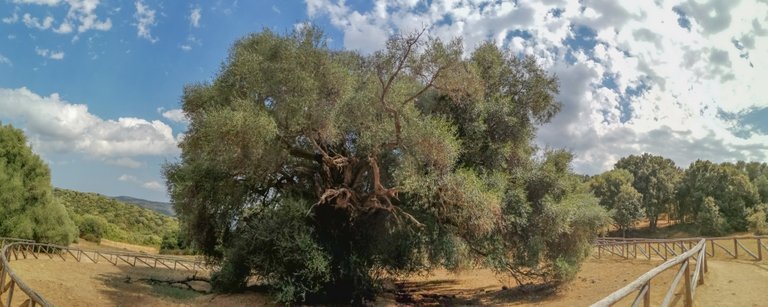
The Patriarch.

Unfortunately we were unable to admire it up close, for safety reasons both for the plant itself and for visitors, the area was limited, although its branches that have seen the centuries pass are no longer as solid as they used to be. but it is fascinating to think that a living creature has placed its roots on this earth for 4000 years. I am convinced, also seeing the effects of my botanical works, that plants can somehow perceive the treatments and what happens around them. I think about what the Patriarch may have perceived in all these centuries, wars that he did not cry, followed by periods of peace, saw the history of our country flow through its branches, from well before the Roman Empire, passing through the Middle Ages and Renaissance. Who knows how many people he has given shelter, a little comfort in the torrid Sardinian summers, how many have been able to enjoy its fruits, in a life that seems incredibly long, not to think about the periods in which he will be bored, maybe for years it is not no one passed by to greet him. Who knows, who knows, a thousand and more assumptions could be made, but surely all this will remain a secret that only he knows and will be held tight for centuries.
While you could not get close to the Patriarch, it was allowed to closely explore the other millennial olive tree, about 2500 years old, which although not a record, remains an immensity. This Olivastro, however, thanks to its conformation, is even more fascinating on a visual level. From the outside it looks like a gigantic bush of Mediterranean scrub, you can't see anything through it, as you can see from the photo I took of Giovanna, you can see the size of this tree and the fact that at first glance it doesn't look like a trunk tree.

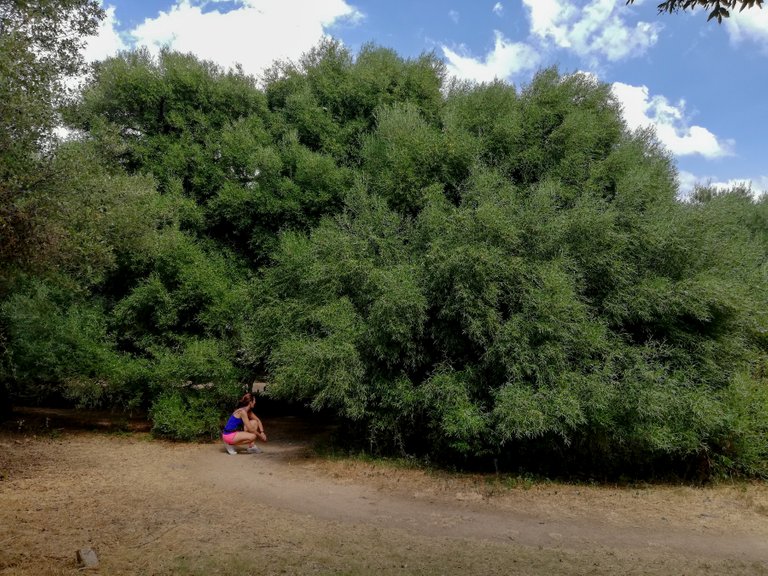
The exterior from the 2,500-year-old olive tree.

But when you approach and enter through that small opening in its canopy, it feels like you are going through a portal and entering another world. A sort of room opens up, a curtain, whatever you want to call it, is the same, however a closed space created by the intertwining of hundreds of branches and foliage, with a mammoth pillar in the center that supports all this splendor. For us it was a fantastic discovery, we did not expect such a show and I think you can feel our joy from the smiles we have. You know, one thing that struck us a lot, was the air we breathed in that environment that created the olive, fresh and full of positive energy, gave a pure and wonderful contact with nature, which I will not forget, I it has remained imprinted and I will keep it in my heart.

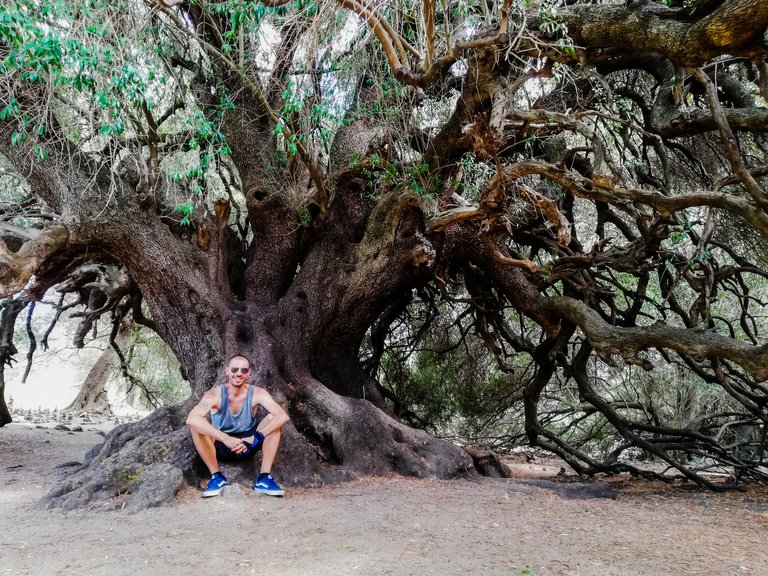
The interior of the room formed by the canopy.

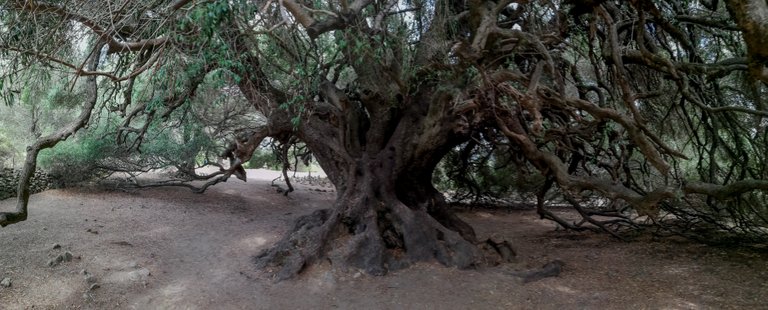



Finally there was also a younger brother, just so to speak, 500 years old, who had a structure similar to the previous one as you can see in the photos, but obviously having only a fifth of his age he was still modest in size, but promised a lot well, it's a pity that I won't have time to see it grow, unfortunately we have different rhythms.

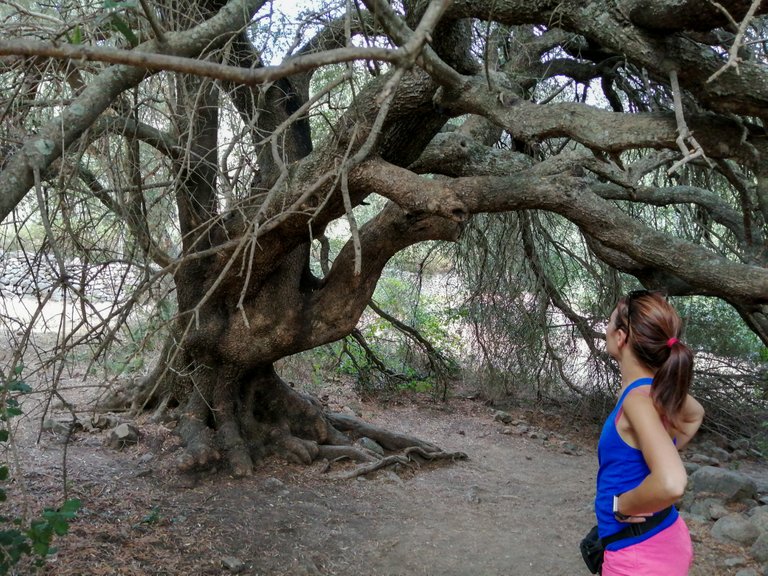
500 year old olive tree.

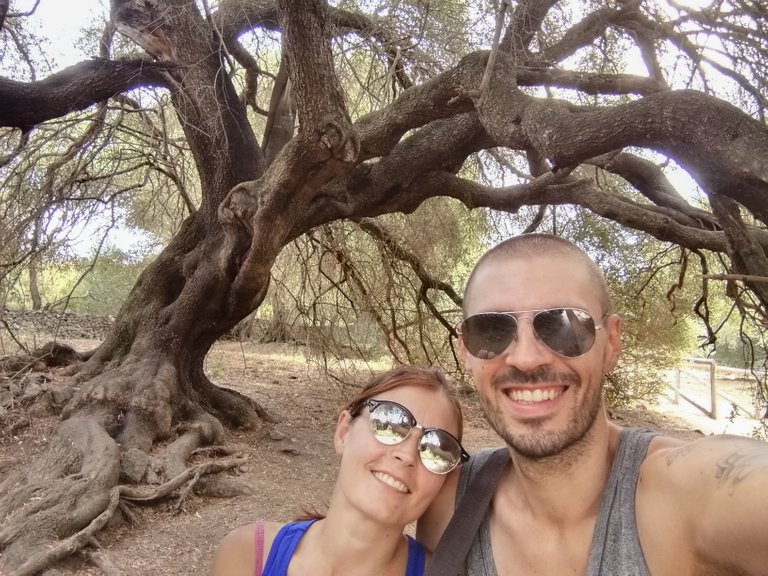

I do not want to prolong myself further, I would like to write many more things regarding personal thoughts, but what was important to say is there, I stop here so as not to weigh down the text. But I want to advise you to visit these 3 trees if you ever find yourself in Sardinia, near Luras in the central northern part of the island. It is not an occasion that happens every day to be able to observe a living creature that counts thousands of years, I guarantee you that if you love nature it is a sight not to be missed. I hope you enjoyed this post dear friends, always give yourself a thought for nature, it is our job to preserve it, because we too are part of it and exist thanks to it, a hug.

All images in this post are the property of the author.
Dear friends this is all, I hope you found this post interesting. Stay tuned for the next news, Thanks for your attention.

🇮🇹
Buongiorno cari amici di Hive, alcuni di voi potrebbero averne sentito parlare o visto in televisione, sul programma Freedom, ma credetemi, essere di persona dinanzi al Patriarca, l'olivastro più antico del mondo, nonché una delle piante più longeve conosciute sul nostro pianeta, è un'emozione unica.


Lago Liscia, Luras.

Dunque, continuando il nostro viaggio nell'entroterra Sardo, ci trovavamo nelle vicinanze di Luras, dove sapevo, avendo visto appunto il programma in televisione, che vi era un sito chiamato i Millenari Olivastri di Luras. Come sapete, ho una passione infinita per pollice verde e botanica, non potevo perdere questa occasione.
Arrivati nel luogo d'interesse, nei pressi di un bellissimo bacino di acqua dolce, incastonato tra i monti, il Lago Liscia, su un versante dei stessi, si trovava questo piccolo parco, molto ben accudito, dove, nel bel mezzo di una foresta di olivastri(Olivi selvatici), sorgevano tre imponenti piante della medesima specie, tra cui il Patriarca. Uno spettacolo della natura, che da oltre 4000 anni veglia sui monti della Gallura, come un emblema di tenacia. Rappresenta l'essenza della vita stessa, come gli alberi che donano l'aria pura a cui tutti gli esseri viventi accingono e che ci permette di continuare nella nostra umile esistenza, dinanzi tanta maestosità.


Il Patriarca.

Per quanto riguarda la presunta età, secondo le informazioni raccolte in loco dalla giuda, fu grazie a degli studi effettuati su un altro olivastro millenario, che dovette essere abbattuto poi ché malato, si poté risalire all'età del Patriarca e dei suoi fratelli più piccoli, di 2500 e 500 anni, tramite calcoli basati sugli anelli dei tronchi tagliati. Un'altra informazione che ci fu fornita dalla guida, è che questo tipo di albero continua crescere per tutta la vita, diminuendo il tasso di crescita man mano che passano gli anni, arrivando a crescere di sole piccole frazioni di millimetro all'anno, quando raggiungono un'età come quella del Patriarca.


Il Patriarca.

Purtroppo non lo abbiamo potuto ammirare in modo ravvicinato, per questioni di sicurezza sia per la pianta stessa che per i visitatori, l'area era circoscritta, per quanto mastodontico i suoi rami che hanno visto scorrere i secoli non sono più solidi come un tempo, ma è affascinante pensare che una creatura vivente, posi le sue radici su questa terra da ben 4000 anni. Io sono convinto, vedendo anche gli effetti dei mie lavori botanici, che le piante possano in qualche modo percepire le cure e quello che accade attorno ad esse. Penso a cosa può aver percepito il Patriarca in tutti questi secoli, guerre che non ha pianto, susseguite da periodi di pace, ha visto scorrere tra i suoi rami la storia del nostro paese, da ben prima dell'Impero Romano, passando per Medioevo e Rinascimento. Chissà a quante persone ha dato riparo, un po' di conforto nelle torride estati sarde, quanti hanno potuto godere dei suoi frutti, in una vita che sembra incredibilmente lunga, per non pensare ai periodi in cui si sarà annoiato, magari per anni non è passato nessuno a salutarlo. Chissà, chissà, si potrebbero fare mille e più supposizioni, ma sicuramente tutto questo rimarrà un segreto che solo lui conosce e si terrà stretto nei secoli.
Mentre non ci si poteva avvicinare al Patriarca, era consentito esplorare a stretto contatto l'altro olivastro millenario, di circa 2500 anni, che anche se non sono un record, rimangono un'immensità. Questo Olivastro però, grazie alla sua conformazione, risulta ancora più affascinante a livello visivo. Dall'esterno sembra un gigantesco cespuglio di macchia mediterranea, non si vede nulla attraverso, come potete vedere dalla foto che ho scattato a Giovanna, si coglie la stazza di quest'albero e il fatto che a primo impatto non sembra un albero a fusto.


L'esterno dall'olivastro di 2500 anni.

Ma quando ti avvicini ed entri attraverso quella piccola apertura della sua chioma, sembra di attraversare un portale ed entrare in un altro mondo. Si apre una sorta di stanza, tenda, come volete chiamarla, è uguale, comunque uno spazio chiuso creato dall'intreccio di centinaia di rami e fronde, con al centro un pilastro mastodontico che sorregge tutto questo splendore. Per noi è stata una scoperta fantastica, non ci aspettavamo uno spettacolo simile e penso si percepisce la nostra gioia dai sorrisi che abbiamo. Sapete, una cosa che ci aveva colpito molto, era l'aria che si respirava in quell'ambiente che aveva creato l'olivastro, fresca e ricca di energia positiva, conferiva un contatto con la natura puro e meraviglioso, che non dimenticherò, mi è rimasto impresso e lo conserverò nel cuore.


L'intenterno della stanza formata della chioma.





Infine vi era anche un fratellino più piccolo, di soli si fa per dire, 500 anni, che aveva una struttura simile al precedente come potete osservare nelle foto, ma ovviamente avendo solo un quinto della sua età era ancora di modeste dimensioni, ma prometteva molto bene, peccato che non avrò il tempo per vederlo crescere, abbiamo ritmi diversi purtroppo.


Olivastro di 500 anni.



Non voglio prolungarmi ancora, vorrei scrivere ancora molte cose per quanto riguardano pensieri personali, ma quello che era importante dire c'è, mi fermo qui per non appesantire il testo. Ma voglio consigliarvi di fare visita a questi 3 alberi se mai vi trovaste in Sardegna, vicino a Luras nella parte centrale a nord dell'isola. Non è un'occasione che capita tutti i giorni di poter osservare una creatura vivente che conta ben migliaia di anni, vi garantisco che se amate la natura è uno spettacolo da non perdere. Spero che questo post vi sia piaciuto cari amici, concedetevi sempre un pensiero per la natura, è compito nostro preservarla, perchè ne facciamo parte anche noi ed esistiamo grazie ad essa, un abbraccio.

Tutte le immagini presenti in questo post, sono di proprietà dell'autore.
Cari amici con questo è tutto, spero che abbiate trovato interessante questo post. Rimanete connessi per le prossime novità, Grazie per la vostra attenzione.
!discovery 30
Grazie mille!!!
!BEER
!lol
This post was shared and voted inside the discord by the curators team of discovery-it
Join our community! hive-193212
Discovery-it is also a Witness, vote for us here
Delegate to us for passive income. Check our 80% fee-back Program
Yay! 🤗
Your content has been boosted with Ecency Points, by @stea90.
Use Ecency daily to boost your growth on platform!
Support Ecency
Vote for new Proposal
Delegate HP and earn more